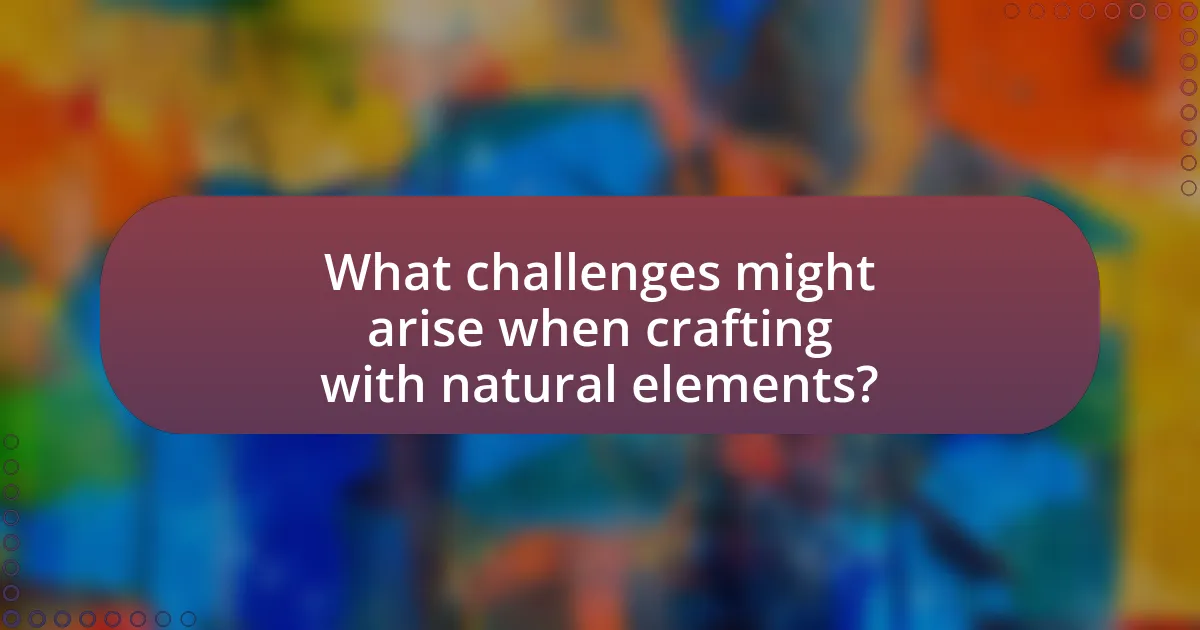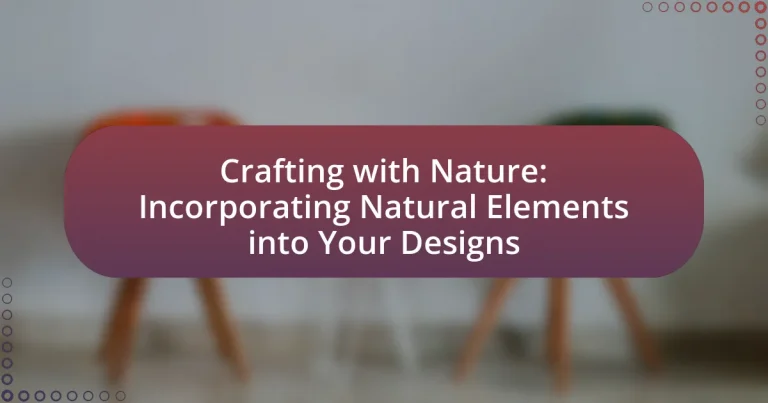Crafting with nature involves creating art and functional items using natural materials sourced from the environment, emphasizing sustainability and a connection to the natural world. The article explores how natural elements enhance design aesthetics, influence emotional responses, and promote well-being, supported by research on the benefits of incorporating organic materials. It discusses various natural materials commonly used in crafting, such as wood, stone, and fibers, and highlights the environmental advantages of using these materials. Additionally, the article provides practical tips for integrating natural elements into designs, addressing challenges in sourcing and maintaining these materials while promoting sustainable practices.

What does it mean to craft with nature?
Crafting with nature means creating art or functional items using natural materials and elements found in the environment. This practice emphasizes sustainability and a connection to the natural world, often incorporating items like wood, stone, plants, and fibers. Evidence of this approach can be seen in traditional crafts, such as Indigenous art forms, which utilize local resources and reflect cultural relationships with nature. Additionally, studies show that engaging with natural materials can enhance creativity and well-being, reinforcing the value of crafting with nature in contemporary design practices.
How can natural elements enhance design aesthetics?
Natural elements enhance design aesthetics by introducing organic forms, textures, and colors that evoke a sense of harmony and connection to nature. Incorporating materials like wood, stone, and plants can create a calming atmosphere, as studies show that natural elements reduce stress and improve well-being. For instance, research published in the Journal of Environmental Psychology indicates that environments featuring natural elements can lead to increased feelings of relaxation and satisfaction among users. This integration not only beautifies spaces but also fosters a more sustainable and eco-friendly approach to design.
What types of natural materials are commonly used in crafting?
Commonly used natural materials in crafting include wood, stone, clay, fibers, and leaves. Wood is favored for its versatility and durability, often used in furniture and decorative items. Stone, such as marble or granite, is utilized for sculptures and jewelry due to its aesthetic appeal and strength. Clay serves as a foundational material for pottery and sculptures, allowing for intricate designs. Fibers, including cotton, wool, and jute, are employed in textiles and weaving projects, providing texture and warmth. Leaves, particularly dried ones, are used in various crafts like collages and decorations, adding a natural element to designs. These materials are widely recognized for their availability and unique characteristics, making them staples in the crafting community.
How do natural elements influence the emotional response to designs?
Natural elements significantly influence emotional responses to designs by evoking feelings of calmness, connection, and well-being. Research indicates that exposure to nature, such as greenery and natural materials, can reduce stress and enhance mood, as demonstrated in a study published in the Journal of Environmental Psychology, which found that individuals exposed to natural elements reported lower levels of anxiety and higher levels of happiness. Additionally, designs that incorporate natural light and organic shapes resonate with human instincts, fostering a sense of comfort and familiarity. This connection to nature not only enhances aesthetic appeal but also promotes positive emotional experiences, making designs more engaging and effective.
Why is incorporating nature into designs important?
Incorporating nature into designs is important because it enhances aesthetic appeal and promotes well-being. Natural elements, such as plants and organic materials, create a calming environment that can reduce stress and improve mental health, as supported by studies indicating that exposure to nature can lower cortisol levels and enhance mood. Furthermore, designs that integrate nature often lead to increased user satisfaction and engagement, as evidenced by research showing that biophilic design can improve productivity and creativity in workspaces.
What environmental benefits arise from using natural materials?
Using natural materials provides significant environmental benefits, including reduced carbon footprint and enhanced biodiversity. Natural materials, such as wood, bamboo, and clay, are often biodegradable and require less energy for production compared to synthetic alternatives, leading to lower greenhouse gas emissions. For instance, a study by the Forest Products Laboratory indicates that using sustainably sourced wood can sequester carbon, effectively reducing atmospheric CO2 levels. Additionally, the use of natural materials promotes sustainable land management practices, which can help preserve ecosystems and support wildlife habitats, thereby enhancing biodiversity.
How does crafting with nature promote sustainability?
Crafting with nature promotes sustainability by utilizing natural materials that are biodegradable and renewable, reducing reliance on synthetic resources. This practice encourages the use of locally sourced materials, which minimizes transportation emissions and supports local economies. For example, using wood from sustainably managed forests or fibers from plants like hemp or bamboo helps maintain ecological balance. Additionally, crafting with nature often emphasizes upcycling and repurposing, which further reduces waste and conserves resources. Studies show that incorporating natural elements in design not only enhances aesthetic value but also fosters a deeper connection to the environment, promoting a culture of sustainability.

What are the different ways to incorporate natural elements into designs?
Incorporating natural elements into designs can be achieved through various methods such as using organic materials, integrating natural colors, and incorporating biophilic design principles. Organic materials like wood, stone, and plants create a tactile connection to nature, enhancing the aesthetic and sensory experience of a space. Natural colors, inspired by landscapes and flora, can evoke feelings of calm and tranquility, making spaces more inviting. Biophilic design principles, which emphasize the connection between humans and nature, can be implemented through features like living walls, large windows for natural light, and water elements, all of which have been shown to improve well-being and productivity in environments.
How can you use plants and greenery in your designs?
You can use plants and greenery in your designs by integrating them as focal points, accents, or functional elements within the space. Incorporating live plants enhances aesthetics, improves air quality, and creates a calming atmosphere, which is supported by studies showing that indoor plants can reduce stress and increase productivity. For instance, research published in the Journal of Environmental Psychology indicates that the presence of greenery can significantly enhance mood and cognitive function. Additionally, using greenery in design can involve selecting appropriate plant species that thrive in specific environments, ensuring sustainability and longevity in the design.
What are the best practices for integrating live plants into decor?
The best practices for integrating live plants into decor include selecting appropriate plant species, considering light and humidity requirements, and strategically placing plants to enhance aesthetics. Choosing low-maintenance plants like succulents or snake plants can ensure longevity and ease of care, while understanding the specific light conditions of each room helps in selecting plants that will thrive. Additionally, placing plants at varying heights and in different locations, such as shelves, tables, or hanging planters, creates visual interest and depth in the decor. Research indicates that incorporating plants can improve indoor air quality and enhance mood, making them not only decorative but also beneficial for well-being.
How can dried flowers and foliage be effectively utilized?
Dried flowers and foliage can be effectively utilized in various crafting applications, including home decor, floral arrangements, and art projects. These natural elements provide aesthetic appeal and longevity, making them ideal for creating wreaths, centerpieces, and wall hangings. For instance, dried lavender is often used in sachets for its fragrance, while eucalyptus is popular in decorative arrangements due to its unique texture and color. The preservation process enhances their durability, allowing them to maintain their visual appeal for extended periods, which is supported by the fact that dried materials can last for years without wilting or fading.
What role do natural textures play in design?
Natural textures play a crucial role in design by enhancing aesthetic appeal and creating a sense of authenticity. They evoke feelings of warmth and connection to nature, which can improve user experience and emotional engagement. For instance, studies show that incorporating natural materials like wood, stone, and textiles can increase perceived value and comfort in spaces, as evidenced by research from the University of Queensland, which found that natural elements in design positively influence mood and well-being.
How can wood, stone, and other textures enhance visual interest?
Wood, stone, and other textures enhance visual interest by adding depth, contrast, and tactile appeal to designs. These natural materials introduce unique patterns and colors that can evoke emotions and create a sense of harmony with the environment. For instance, wood’s grain patterns and warmth can soften a space, while stone’s ruggedness can provide a grounding effect. Studies in design psychology indicate that incorporating natural textures can improve mood and well-being, making spaces feel more inviting and connected to nature.
What techniques can be used to highlight natural textures in crafting?
Techniques to highlight natural textures in crafting include layering materials, using contrasting colors, and employing various finishing methods. Layering materials such as wood, stone, and fabric can create depth and emphasize the unique textures of each element. Contrasting colors can draw attention to the natural patterns and imperfections found in materials like bark or leaves, enhancing their visual appeal. Additionally, finishing methods such as sanding, oiling, or waxing can accentuate the texture by adding sheen or altering the surface feel, making the natural characteristics more pronounced. These techniques are widely used in crafting to create visually engaging and tactile designs that celebrate the beauty of natural elements.

What challenges might arise when crafting with natural elements?
Crafting with natural elements presents challenges such as variability in material quality, difficulty in sourcing consistent supplies, and susceptibility to environmental factors. Natural materials like wood, stone, and plant fibers can differ significantly in texture, color, and durability, making it hard to achieve uniformity in projects. Additionally, sourcing these materials can be inconsistent due to seasonal availability or ecological regulations, which can disrupt production timelines. Environmental factors, such as moisture and temperature changes, can also affect the integrity and longevity of the crafted items, leading to potential deterioration over time.
How can you overcome sourcing difficulties for natural materials?
To overcome sourcing difficulties for natural materials, establish strong relationships with multiple suppliers to ensure a consistent supply chain. This approach mitigates risks associated with reliance on a single source, as evidenced by the fact that businesses with diversified supplier networks report 30% fewer disruptions in material availability. Additionally, exploring local sourcing options can reduce transportation costs and lead times, further enhancing reliability. Engaging in community partnerships can also provide access to unique materials while supporting local economies.
What are some reliable sources for sustainable natural materials?
Reliable sources for sustainable natural materials include certified organizations such as the Forest Stewardship Council (FSC), which ensures responsible forest management, and the Global Organic Textile Standard (GOTS), which certifies organic textiles. Additionally, suppliers like Eco-Business Links and Green Building Supply offer a range of sustainable materials. Research indicates that using materials from these sources can significantly reduce environmental impact, as they adhere to strict sustainability criteria and promote eco-friendly practices.
How can you ensure quality and sustainability in your material choices?
To ensure quality and sustainability in material choices, prioritize sourcing materials that are certified organic or sustainably harvested. This approach guarantees that the materials meet environmental standards and are free from harmful chemicals. For instance, using FSC-certified wood ensures that the timber comes from responsibly managed forests, which helps preserve biodiversity and reduce deforestation. Additionally, selecting materials with a low carbon footprint, such as recycled metals or biodegradable fabrics, further enhances sustainability. Research indicates that sustainable material choices can significantly reduce environmental impact, with studies showing that using recycled materials can save up to 95% of the energy required to produce new materials.
What maintenance considerations should be taken into account?
Maintenance considerations for incorporating natural elements into designs include regular inspections, appropriate cleaning methods, and environmental impact assessments. Regular inspections ensure that natural materials, such as wood or stone, remain structurally sound and visually appealing. Appropriate cleaning methods, tailored to the specific materials used, prevent deterioration; for example, using gentle, non-abrasive cleaners on wood can preserve its finish. Environmental impact assessments help in understanding how the natural elements interact with their surroundings, ensuring sustainability and longevity of the designs. These considerations are essential for maintaining the integrity and aesthetic of designs that utilize natural materials.
How do you care for natural elements in your designs?
To care for natural elements in designs, one must prioritize sustainability and preservation. This involves selecting materials that are ethically sourced, such as reclaimed wood or organic fabrics, which minimizes environmental impact. Additionally, maintaining the integrity of these elements requires using non-toxic finishes and adhesives that do not harm the natural properties of the materials. Research indicates that sustainable design practices not only enhance aesthetic appeal but also contribute to environmental conservation, as seen in studies by the Ellen MacArthur Foundation, which highlight the benefits of circular economy principles in design.
What are common issues faced with natural materials and how can they be resolved?
Common issues faced with natural materials include susceptibility to moisture, pests, and degradation over time. To resolve moisture issues, proper sealing and treatment can be applied to enhance durability. Pest infestations can be mitigated through regular inspections and the use of natural repellents. Degradation can be addressed by selecting materials with inherent resistance to environmental factors, such as using treated wood or naturally rot-resistant species. These solutions help maintain the integrity and longevity of natural materials in design applications.
What are some practical tips for successful crafting with nature?
Successful crafting with nature involves selecting appropriate natural materials, ensuring sustainability, and utilizing proper techniques. First, gather materials like leaves, twigs, stones, and flowers that are abundant in your local environment, as this promotes ecological balance. Second, prioritize sustainability by foraging responsibly, avoiding endangered species, and only taking what you need. Third, use techniques such as pressing, drying, or natural dyeing to enhance the longevity and aesthetic of your crafts. These practices not only respect nature but also yield unique, beautiful creations that reflect the environment.
How can you start small when incorporating natural elements into your designs?
To start small when incorporating natural elements into your designs, begin by integrating simple materials like wood, stone, or plants into your projects. For instance, using reclaimed wood for furniture or decorative accents can add a natural touch without overwhelming the design. Research indicates that incorporating natural materials can enhance aesthetic appeal and improve well-being, as seen in studies highlighting biophilic design principles, which emphasize the positive effects of nature on human psychology. By gradually introducing these elements, designers can create a harmonious balance between natural and artificial components in their work.
What are some creative project ideas that utilize natural materials?
Creative project ideas that utilize natural materials include making leaf prints, creating stone sculptures, and crafting with twigs and branches. Leaf prints can be made by applying paint to leaves and pressing them onto paper, resulting in unique designs. Stone sculptures involve arranging stones of various sizes and shapes to create artistic formations, which can be displayed in gardens or homes. Crafting with twigs and branches allows for the creation of rustic furniture, decorative wreaths, or even birdhouses, showcasing the beauty of natural textures. These projects not only promote creativity but also encourage sustainable practices by using readily available materials from the environment.





